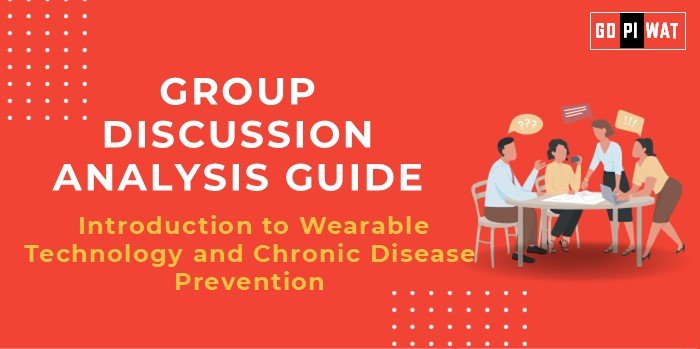📋 Group Discussion (GD) Analysis Guide
🌟 Introduction to Wearable Technology and Chronic Disease Prevention
- Opening Context: Chronic diseases such as diabetes, cardiovascular conditions, and hypertension are rising globally, contributing significantly to mortality and healthcare costs. Wearable technology like smartwatches, fitness trackers, and biosensors is gaining attention as a tool for early detection and prevention.
- Topic Background: Since their emergence in the 2010s, wearable devices have transitioned from luxury items to critical health monitoring tools. With advancements in AI and IoT, their capacity for real-time tracking and predictive analytics has grown.
📊 Quick Facts and Key Statistics
- 📈 Market Growth: Global wearable technology market projected to reach $150 billion by 2027.
- 👩💻 Adoption Rates: 30% of adults in developed countries use wearables.
- ⚕️ Impact Metrics: Studies suggest wearables reduce hospital readmissions by 20%.
- 🌍 Prevalence of Chronic Diseases: 60% of deaths worldwide are attributed to chronic diseases (WHO).
🔗 Stakeholders and Their Roles
- 🏢 Tech Companies: Innovate and develop wearable technology solutions (e.g., Apple, Fitbit, Garmin).
- 🏥 Healthcare Providers: Integrate wearable data into care plans for enhanced monitoring.
- 🏛️ Government and Regulators: Establish policies and data privacy frameworks to support wearable adoption.
- 👥 Consumers: Leverage devices for proactive health management.
🏆 Achievements and Challenges
✨ Achievements:
- 💡 Early Detection: Devices like the Apple Watch detect irregular heart rates and arrhythmias.
- 📉 Chronic Disease Management: Continuous glucose monitoring reduces complications in diabetic patients.
- 💪 Healthier Lifestyles: Enhanced fitness and activity tracking promotes well-being.
⚠️ Challenges:
- 🔒 Data Privacy: Concerns about sharing sensitive health information.
- 💰 Accessibility: High costs limit adoption in low-income regions.
- ⚙️ Reliability: Instances of false alarms or inaccurate readings.
Global Comparisons:
- 🇸🇪 Success: Scandinavian countries have integrated wearables with public health systems.
- 🇺🇸 Challenges: Data misuse scandals in the US highlight privacy risks.
Case Studies:
- 📊 A 2023 Stanford study showed wearable users achieved a 15% higher adherence to physical activity goals.
💡 Structured Arguments for Discussion
- Supporting Stance: “Wearable technology significantly reduces the risk of late-stage diagnosis by providing continuous monitoring and early alerts.”
- Opposing Stance: “Limited accessibility and questionable data accuracy undermine the effectiveness of wearables in chronic disease prevention.”
- Balanced Perspective: “While wearables show potential, widespread adoption depends on addressing privacy concerns and ensuring equitable access.”
🎯 Effective Discussion Approaches
- Opening Approaches:
- 📊 Begin with statistics on rising chronic disease rates and wearable adoption.
- 📖 Use a case study of a successful health intervention using wearables.
- Counter-Argument Handling:
- 🔒 Address concerns by highlighting advances in encryption and affordability strategies.
📈 Strategic Analysis of Strengths and Weaknesses
- 💪 Strengths: Real-time monitoring, preventive healthcare benefits.
- 🛑 Weaknesses: Cost and data security challenges.
- 🌟 Opportunities: Partnerships with insurance providers and governments.
- ⚡ Threats: Regulatory hurdles and consumer skepticism.
🎓 Connecting with B-School Applications
- 📌 Real-World Applications: Wearable data analytics projects in healthcare management or startups.
- 🧐 Sample Interview Questions:
- 💬 “How can wearable technology transform public health systems?”
- 📜 “Discuss the ethical implications of data collected by wearables.”
- 💡 Insights for B-School Students: Wearables offer immense scope for projects in healthcare tech, data analytics, and innovation management.


